The Clarkdale Review: Intel's Core i5 661, i3 540 & i3 530
by Anand Lal Shimpi on January 4, 2010 12:00 AM EST- Posted in
- CPUs
Ridiculously Fun to Overclock
We’ll start off with the obligatory maximum stock VID overclock of a 661 ES Clarkdale using Intel’s retail cooler:
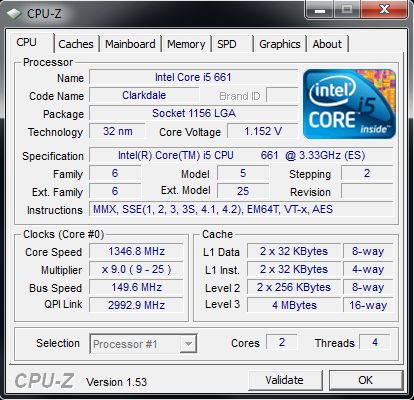
Maximum overclock @ stock voltages (3874MHz)
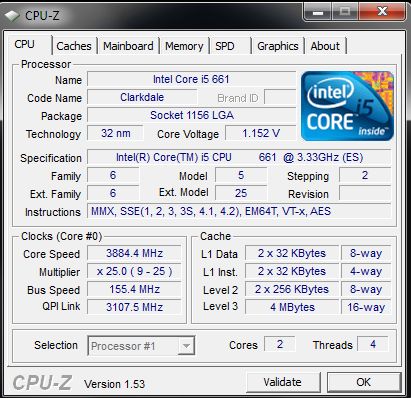
Maximum overclock @ stock voltages without Turbo
With increased core VID, speeds up to 4.3GHz are possible on the stock cooler:
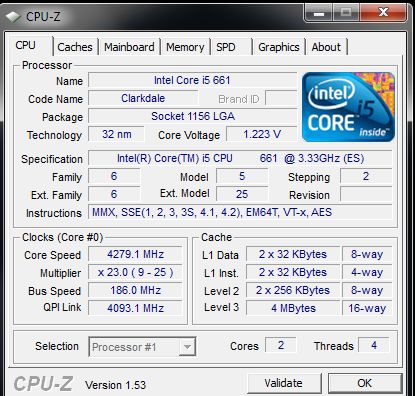
A 0.1V boost puts you in the 4.3GHz ballpark.
Watercooling
Clock for clock performance of Clarkdale against other platforms may not be impressive, but frequency scaling with good cooling is:
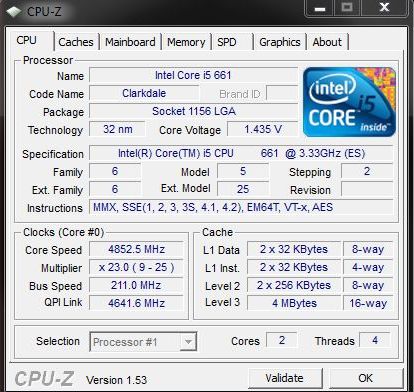
4853 MHz stable comes in with a processor load voltage of around 1.438V. Memory performance is related directly to the QPI link ratio. For best performance, keep the QPI link speed as close as possible to CPU core speed to minimize buffer hold times for lower memory access latency.
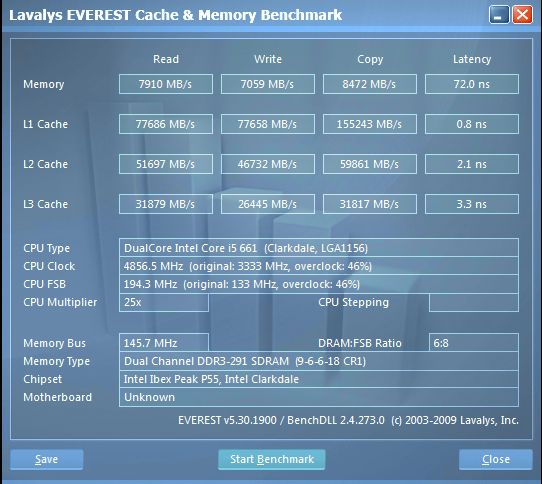
12X QPI Multiplier
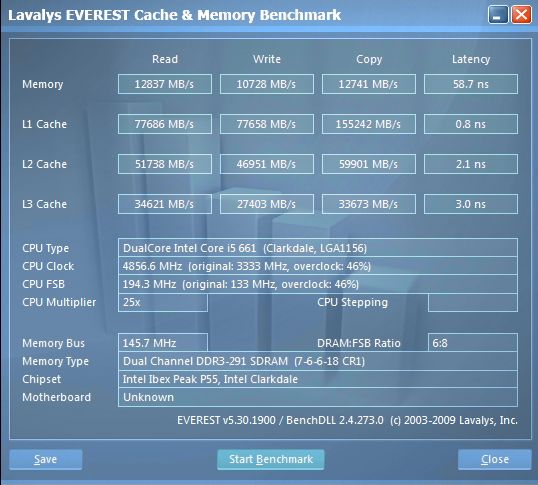
24X QPI Multi
The bandwidth figures are not stellar on either side of the scale (bear in mind the Everest bench DLL needs an update for Clarkdale). However, the higher QPI multiplier ratio is essentially free for the taking; requiring no additional IMC (VTT) voltage increase until BCLK is increased past 210 or so.
Like Lynnfield and Bloomfield, odd CPU multiplier ratios are more stable than even, although the disparity is less pronounced on Clarkdale. We found that even multipliers needed higher VCore at the same overall processor frequency or needed to be run at a lower overall overclock for stability. We’re not sure on the exact cause of this issue but it’s likely to be related to frequency synthesis within the CPU and downstream logic sampling.
Another caveat with Clarkdale overclocking is that the platform seems to be limited to memory speeds below 1600MHz as soon as you increase BCLK significantly (speeds over 1600Mhz are possible at stock BCLK). We’d hedge bets this is due to the memory controller relying on a preset DRAM clock skew table like Intel’s Front Side Bus architectures of old. The current DRAM frequency ceiling means that you’ll be shooting for CAS 5/6 capable memory between 1300-1600MHz for best performance with 4GB of RAM. 8GB configurations require a loose set of sub-timings, and also a 2N Command Rate to achieve 1600 MHz stable on our sample processor.
Sub-Zero
Bloomfield was hit and miss when it came to frequency scaling at low temperatures. Clarkdale seems to be a different animal altogether:

This is what ‘Clarkie’ is good at..
This screenshot was taken with our cascade cooling the CPU. Evaporator head temperatures were in the region of -115 Celsius. Most Lynnfield/Bloomfield CPUs were out of their comfort zone at these temperatures, but Clarkdale seems to be at home. You still get the occasional cold boot bug, but most of the ES CPUs will run benchmarks right down to the boiling point of LN2 (motherboard permitting). We’ve seen screenshots of 3D benchmarking above 6.5GHz and Super Pi runs edging close to 7GHz. Sounds great, but unfortunately, Super Pi 1M is the only benchmark where Clarkdale is really competitive. Once you’re past 230 BCLK, you have to leave QPI frequency on the floor which hurts memory performance in a big way. Couple that with the 1600MHz or so cap on DRAM frequency and you’ll understand why Super Pi 32m doesn’t fare so well on this platform. 3D performance in Futuremark’s 3DMark05 is just about competitive with the current ‘top’ Bloomfield results if you can run Clarkdale at 6.5GHz throughout the bench. The upshot is that we think there will be more good Clarkdale chips capable of 6.5GHz than there are Bloomfield CPUs that can run 3D benchmarks at 5.4GHz. The funny thing is that P55 motherboards using an NF200 to provide triple CrossFire/SLI might actually be the way to go for benchmarks like 3D Mark 05 if you’re into competitive benchmarking!
While Clarkdale may not be the fastest performer from Intel, it’s probably the most fun to overclock.










93 Comments
View All Comments
SydneyBlue120d - Tuesday, February 9, 2010 - link
The Intel G9650 doesn't exist, what You're referring is Intel G6950http://ark.intel.com/Product.aspx?id=43230">http://ark.intel.com/Product.aspx?id=43230
puterfx - Wednesday, February 3, 2010 - link
I've been building systems since the late 90's, mostly for others, and I'm always the last to get a decent system so I decided it was about time for me. I'm running an e6600 on a 3 yr old Intel board w/ 2g of DDR2 RAM and was wondering about the differences between C 2 quad, i3-540, i5-750 or i7-820. I priced out 3 different setups with Gigabyte boards (EP45, H57 & P55 - USB3 ver.) combined with Q8400/9300/9400 on EP45, i3-540,i5-750 and i7-820 on the H57 & P55 and 4 Gb DDR3 RAM (Crucial, Geil, Kingston)so , basically, I had 9 combinations. Excluding the i7, the price range for these builds was about $429 - $487, and I could probably do better if I tried but I was amazed that they were that close (the i7 adds another $100 but not that much improvement in performance that I can see).Looking at your charts, I think I can justify going with the i5-750. I have a decent video card for the occassional gaming that works pretty good for me now (I'll apply the $100 from above to a better card later) but I do a lot of spreadsheets and some photoshop and autocad so I think I'll see a better improvement there.
Thanks again for all your articles. Very well written, understandable and thorough.
KingAlexander - Saturday, January 30, 2010 - link
I too am puzzled by the i7 870 scoring so low on the World of Warcraft chart -- it stood out to me immediately when I first read the article. I was a little surprised to not see it mentioned.It was suggested in another comment that this was due to the game having an issue with hyperthreading, but if that was the case shouldn't the i7 920 also have scored significantly lower than it did?
Bloodx - Monday, January 25, 2010 - link
It should be noted that this new intel system does not workat 1080p/24 correct. The nvidia 9400 chipset works at 1080p/24.
So i've traded audio for skipping.
HTPC is no better off. Sad.
geok1ng - Sunday, January 10, 2010 - link
Previous Intel IGPs managed achieve less terrible numbers in game by cheating- they didn't render all the polygons and textures. So for good measure i require side by side screenshots of the "new, better, faster and cheaper" Intel IGP.The idea of an Intel IGP that simply isn't horrible is SOO strange that a true review would have to go the race: benchmarks, screenshots, minimum playable settings for various games and screenshots. Something the articles on HardOCP.
snakyjake - Wednesday, January 6, 2010 - link
Why isn't the i7-860 tested in the section "Windows 7 Application Performance"?Without the i7-860 in the Windows 7 test section, this review is pointless.
NeBlackCat - Wednesday, January 6, 2010 - link
I was hoping to build a new always-on home server around one of these. Power miserly IGP and idle operation (for when it's only firewalling and routing) but plenty of grunt in reserve for occasional video encoding, compiling and running virtual machines.Looks like they missed the mark for this application, and I couldn't even adopt now and wait for the real deal CPU later, as the socket is a dead end.
IMHO only the HTPC crowd have a reason to be excited here, but there are lots of other (cheaper) ways to get low power 1080p too.
ruetheday - Friday, January 8, 2010 - link
Let's wait and see - There are products coming which will do gpu assisted transcoding that might shift things in Clarkdale's favor.bongbong - Tuesday, January 5, 2010 - link
I know for a fact that the athlon II x3s and x4s have to overclock like crazy in games to reach the same performance delta as their phenom II x3 and x4 brethren(coz of the 6mb cache and many games are dependent on cache)
Ive seen gaming benchmarks on anandtech where the x3 720 matched the x4 965 when they are both overclocked to 3.8ghz.
I was able to buy an x3 720 for only a 110 usd recently.
So why isnt it in the benchmark comparisons?
JohnMD1022 - Tuesday, January 5, 2010 - link
$150 from microcenter.